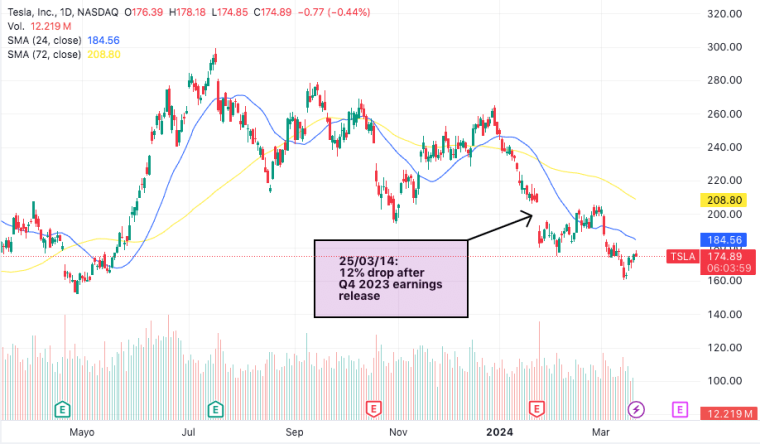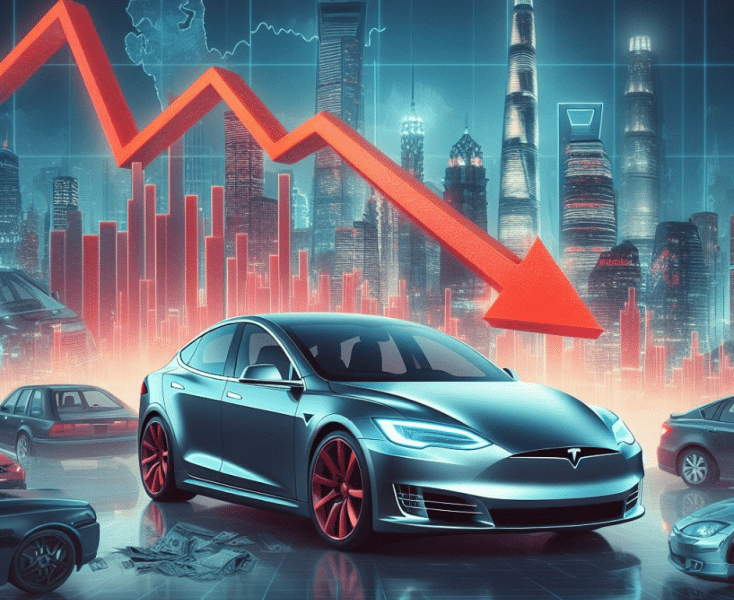Tesla’s previously unstoppable stock has suffered in 2024, dropping almost 29% so far this year as the electric vehicle company faces slowing growth, more competition from other brands, and a clear move toward offering cheaper vehicles. Some market analysts now believe it should no longer be seen as part of the “Magnificent 7,” the group of tech stocks that have driven the market for years.
The latest blow came after Tesla’s Q4 2023 earnings release in late January, which showed decelerating sales and profit growth compared to recent blockbuster years. Shares plummeted over 12% the following day, wiping out around $80 billion in market capitalization in a stark reversal for the company once deemed the world’s most valuable automaker.
While Tesla (TSLA) still reported a 38% year-over-year increase in vehicle deliveries for 2023, handing over 1.8 million cars to customers, the figure fell well short of its previous 50% annual growth targets that captivated investors and fueled an epic stock run-up.
More worryingly, the management team warned that growth in 2024 “may be notably lower” than last year as the company prioritizes the development of a new and more affordable “next-generation” vehicle platform that is expected to launch in the second half of 2025.
Missed Earnings and Rising Costs Spook Investors

Disappointing Q4 earnings figures also rattled Tesla’s bullish narratives regarding its profitability and pricing power. Adjusted earnings per share sank 40% from a year earlier, while revenue of $25.1 billion came in about $500 million below expectations despite recent deep price cuts.
Tesla’s operating margin nearly halved year-over-year to just 8.2%, driven partly by rising costs associated with the launch of its polarizing Cybertruck pickup that went into production late last year.
Also read: Will Tesla Ever Reclaim Its Former Glory? Wave of Downgrades Hits the Stock Hard
Meanwhile, during the company’s Q4 earnings call, the firm’s controversial CEO, Elon Musk, downplayed the prospect of a quick margin rebound, citing high interest rates as one of the factors pressuring prospective buyers.
“If the interest rates come down quickly, I think margins will be good. And if they don’t come down quickly, they won’t be that good”, Musk told analysts. Unfortunately for Musk and Tesla, this is unlikely as the Federal Reserve is signaling caution as the market predicts the first rate cuts to be at least a few months away.
Analysts were highly critical of the lack of strategic vision and financial guidance provided on the call.
We were dead wrong expecting Musk and team to step up like adults in the room on the call and give a strategic and financial overview of the ongoing price cuts, margin structure, and fluctuating demand,” he wrote in a note Thursday
👇https://t.co/H0Ywkh0rY8 @CNN @CNNBusiness— Dan Ives (@DivesTech) January 25, 2024
“We were dead wrong expecting Musk and team to step up like adults in the room on the call and give a strategic and financial overview of the ongoing price cuts, margin structure, and fluctuating demand”, wrote Dan Ives of Wedbush Securities in a scathing note.
Rising Threat from China Pressures Demand Outlook
Musk himself highlighted the existential threat that Tesla now faces from rapidly ascending Chinese automakers like BYD, which overtook Tesla for the first time as the world’s biggest seller of EVs and hybrids in Q4.
“Frankly, I think if there are not trade barriers established, [Chinese automakers] will pretty much demolish most other car companies in the world”, Musk warned during the earnings conference.
His candid comments foreshadowed a looming potential showdown, as European officials have since launched an anti-dumping probe into Chinese EV exports that could lead to higher tariffs if the region determines unfair pricing practices.
The Next Battleground: Affordability
After years of working hard to become a dominant force in the nascent electric vehicles market, Tesla saw its stock valuation rise to lofty levels by achieving promising industry-leading profitability rather than growing at all costs – a strategy followed by most startups in the tech space.
Now, aftermarket conditions have shifted, the company appears to be resolved to pivot squarely toward affordability and cost-cutting – two flagship moves characteristic of Chinese automakers.
“Our key takeaway from the Tesla earnings call was the firm’s strategic shift to the development and ramp-up of the new affordable sport utility vehicle, while focusing on cost cuts for its existing vehicles.” wrote Seth Goldstein, senior equity analyst at Morningstar.
“This marks a change from the 2023 strategy, which was to cut prices to generate strong volume growth.”
Goldstein expects to see a deceleration in Tesla’s number of delivered vehicles to 10% in 2024 and 6% in 2025 as it prioritizes the development of its new affordable model line and keeps ramping up its Cybertruck output. Meanwhile, he forecasts that growth could be reignited to over 20% annually from 2026 onward, fueled by these affordable vehicles.
On the profitability front, Goldstein projects that automotive gross margins will remain depressed at around 19% over the next few years before rebounding as the lower-cost lineup achieves scale in the latter part of the decade.
Tesla Stock Valuation Has Been Reset After Years of Hype

If this profitability outlook holds true, it could mark a rude awakening for investors who bid up Tesla to nosebleed valuations based on the company’s premium pricing power and sky-high growth ambitions.
At its 2021 peak of around $414 per share (post-split), Tesla shares traded at over 20 times projected 2030 sales, reflecting immense optimism that the company could maintain both its rapid growth and stellar profit margins well into the future. The reality is that the stock is now standing at around $175 per share or 58% below that mark. It turns out that the competition was able to catch up with Tesla much faster than expected.
“Tesla is signaling that the days of 50% or even 30% to 40% growth year-over-year is not going to happen in 2024”, Goldstein told Bloomberg after the earnings release.
He cut his fair value estimate for Tesla shares to $200, still above current trading levels but a far cry from its heights just two years ago. Other analysts have also slashed their price targets, with Barclays lowering its projection to $225, down from $250, its previous forecast for the automaker.
Zooming Out: The Rise and Fall of Highflying Valuations
Tesla’s valuation reset resembles similar moves suffered by other recently hyped-up stocks whose underlying business models were forced to confront harsher economic realities after years of exaggerated expectations.
The video conferencing company Zoom (ZM), for instance, became a household name during the remote work boom of the pandemic era. Nearly everyone, from students to workers to grandparents, all started using the app to connect with others online. The company’s stock price increased by over 300% in 2020 alone as revenues skyrocketed.
However, by late 2022, with offices reopening and competitive pressures intensifying, Zoom’s shares have already given up nearly 89% of their value compared to their pandemic peak of $590 per share.
Meanwhile, the cloud data analytics firm Palantir experienced similar euphoria and subsequent reversal, riding the wave of COVID-era digital acceleration to see its shares quadruple from its direct listing in late 2020 through early 2021.
Although the AI boom has helped Palantir stock recover some of that lost territory, the price is still sitting far below its peak of $45 per share booked in 2021. In this particular case, the tailwinds that once lifted the company’s stock valuations have changed entirely. This has cushioned the blow but not yet totally reversed those post-pandemic.
Can Tesla Be Ousted from the ‘Magnificent 7’? This Professor Thinks So
For Jeremy Siegel, the legendary professor of finance emeritus at the University of Pennsylvania’s Wharton School, the revaluation of Tesla and other recent market darlings is a positive sign for overall market health.
“There’s more talk of a Magnificent 6 rather than 7 — highlighting Tesla’s underperformance over last nine months or so.”, Siegel wrote in a recent note, referring to the seven elite group of big tech stocks that has dominated market returns for a while.
“This is a sign of market health; the Magnificent 7 are not being treated all as one group and we see separation between Tesla and the others based on different earnings projections.”, he further commented.
Looking Ahead: The Fallout for Musk?
Aside from the investor fallout, Tesla’s humbling may carry major ramifications for its eccentric CEO as well.
Musk is reportedly seeking to increase his personal ownership stake in Tesla to around 25% from its current 13% level, ostensibly to exert more control and potentially pivot the company toward his growing interests in artificial intelligence and robotics.
The proposal has been met with skepticism by much of Wall Street, with analysts fearing that such a move would further distract Musk from righting the ship, referring to Tesla’s core automotive business.
“If Musk does not get what he wants, will he leave Tesla?”, pondered Peter Cohan, a Senior Contributor to Forbes. “Will he sell the company to a rival more interested in competing in the EV market?”, he further reflexed.
The recent deterioration in Tesla’s business performance and the stock’s dramatic slide in 2024 undercuts Musk’s leverage in such intra-company negotiations and raises the stakes over his ability to quickly refocus on delivering results on Tesla’s primary mission.
If the pivot toward affordability hits roadblocks of its own, Musk may be forced to choose between following his AI side quest or devoting his full energy and ownership stake to the all-electric vehicle trailblazer he founded nearly two decades ago. Either way, 2024 is shaping up to be a make-or-break year for what was once the industry’s most unassailable growth story.
